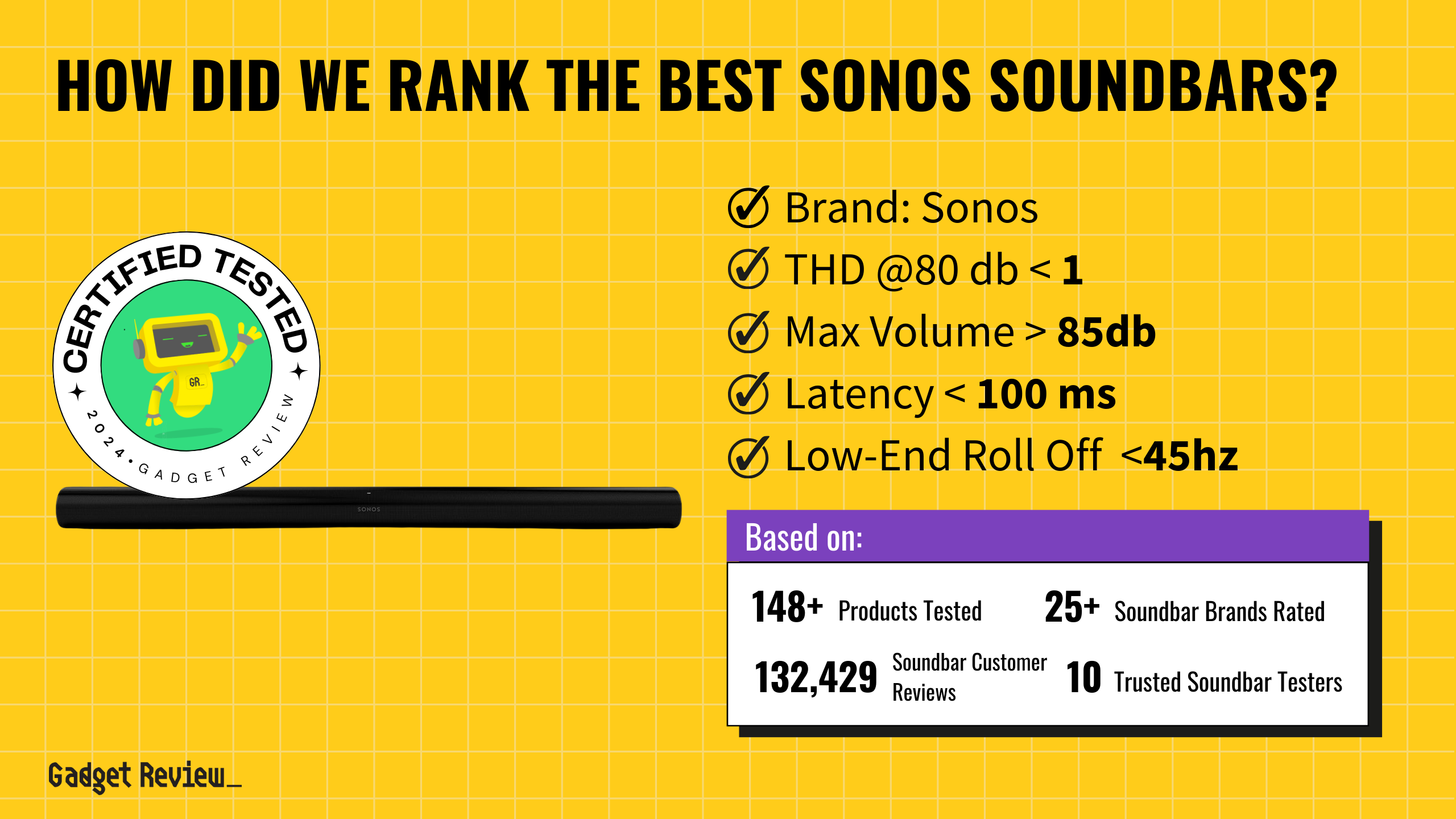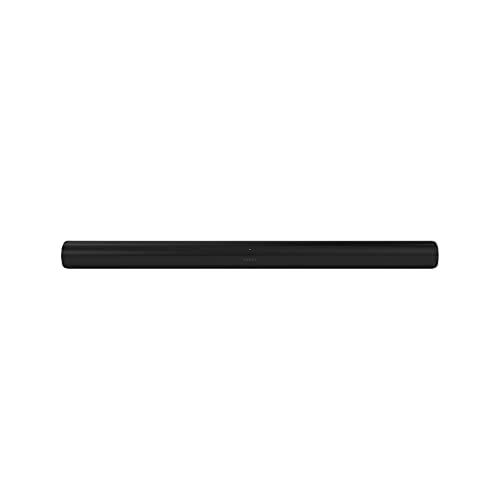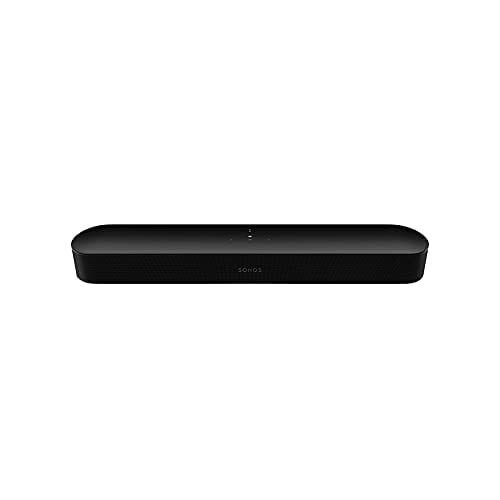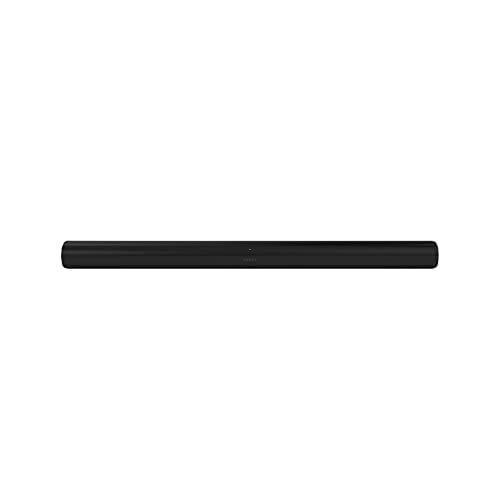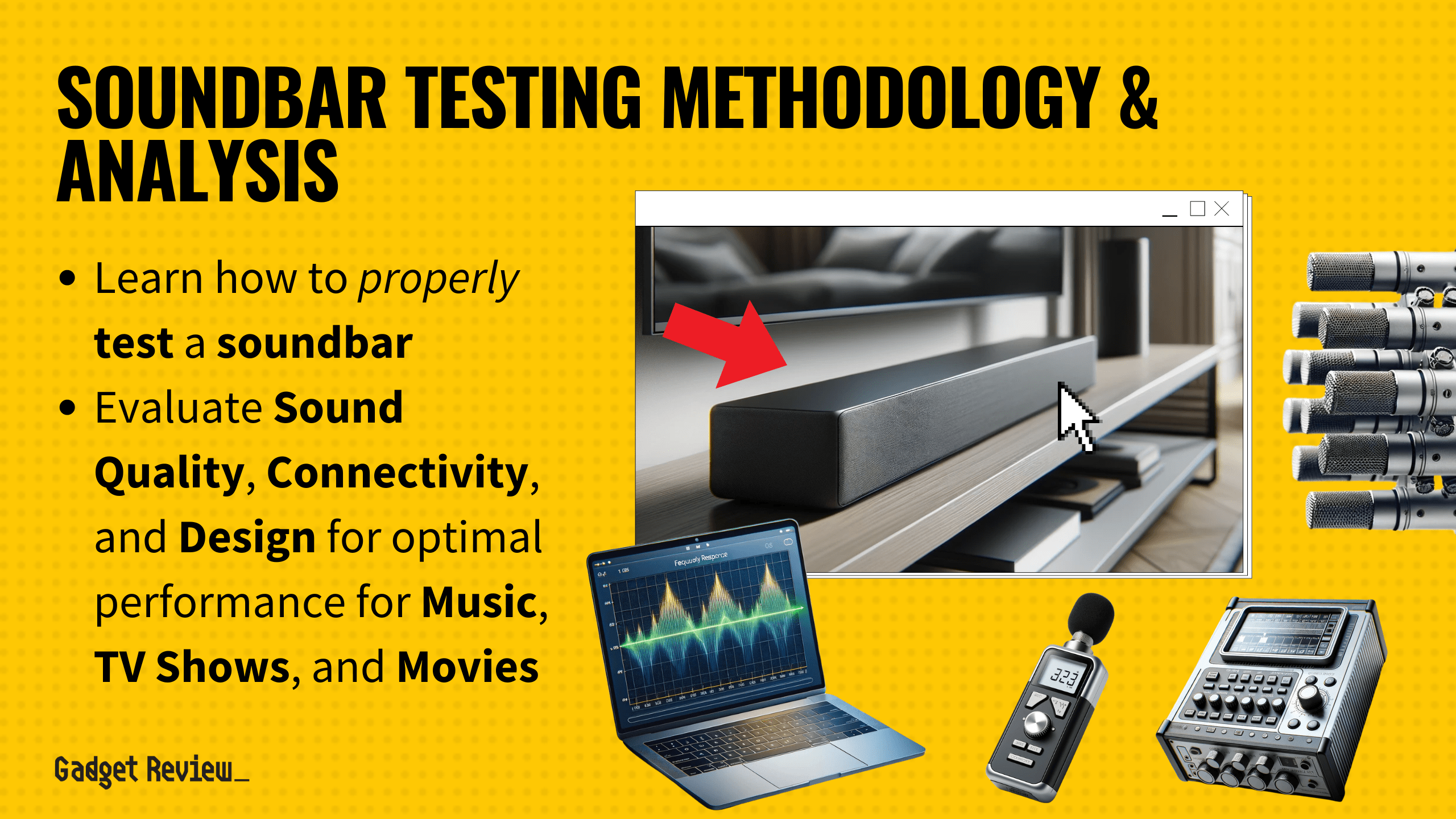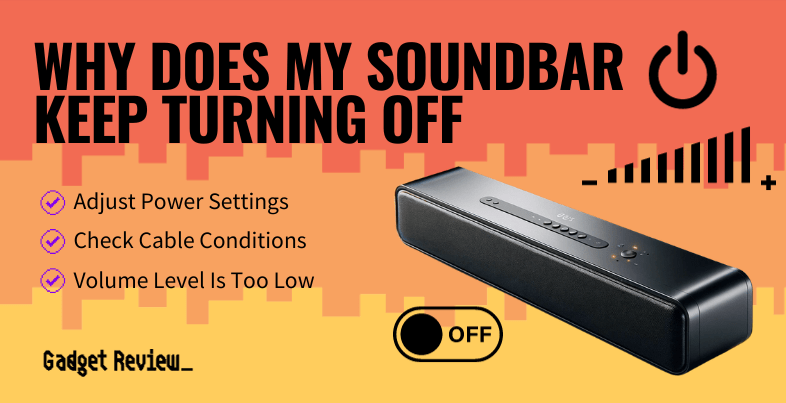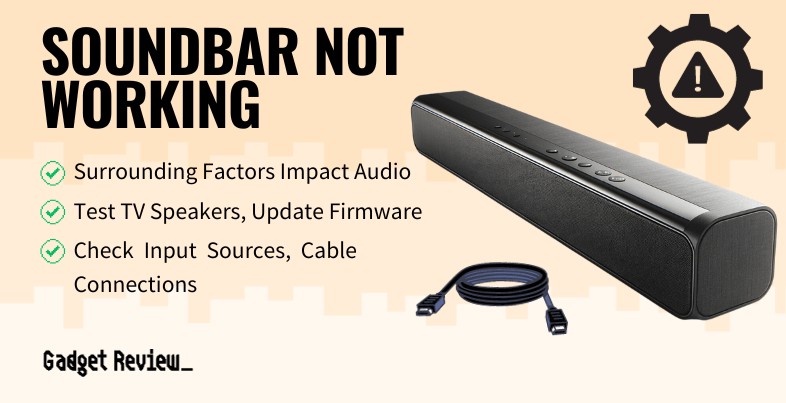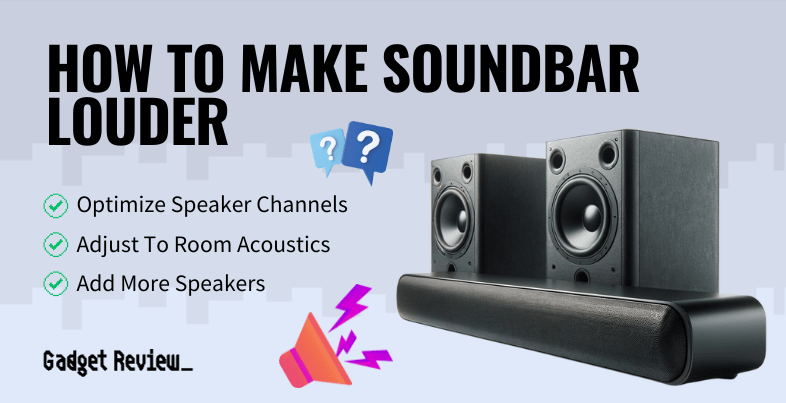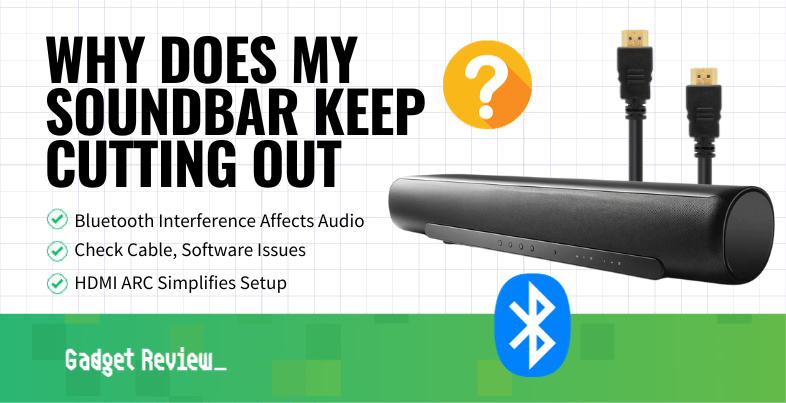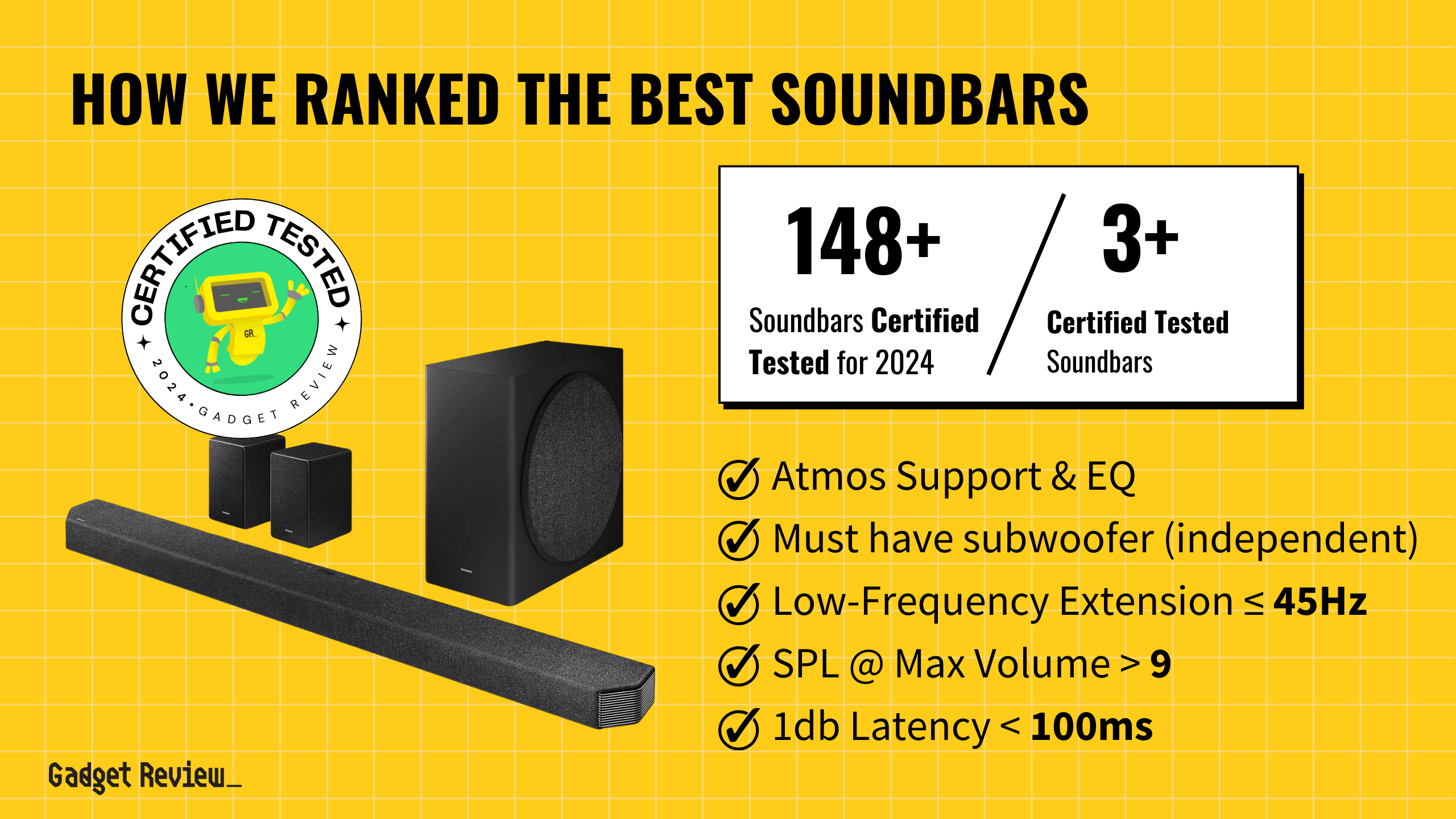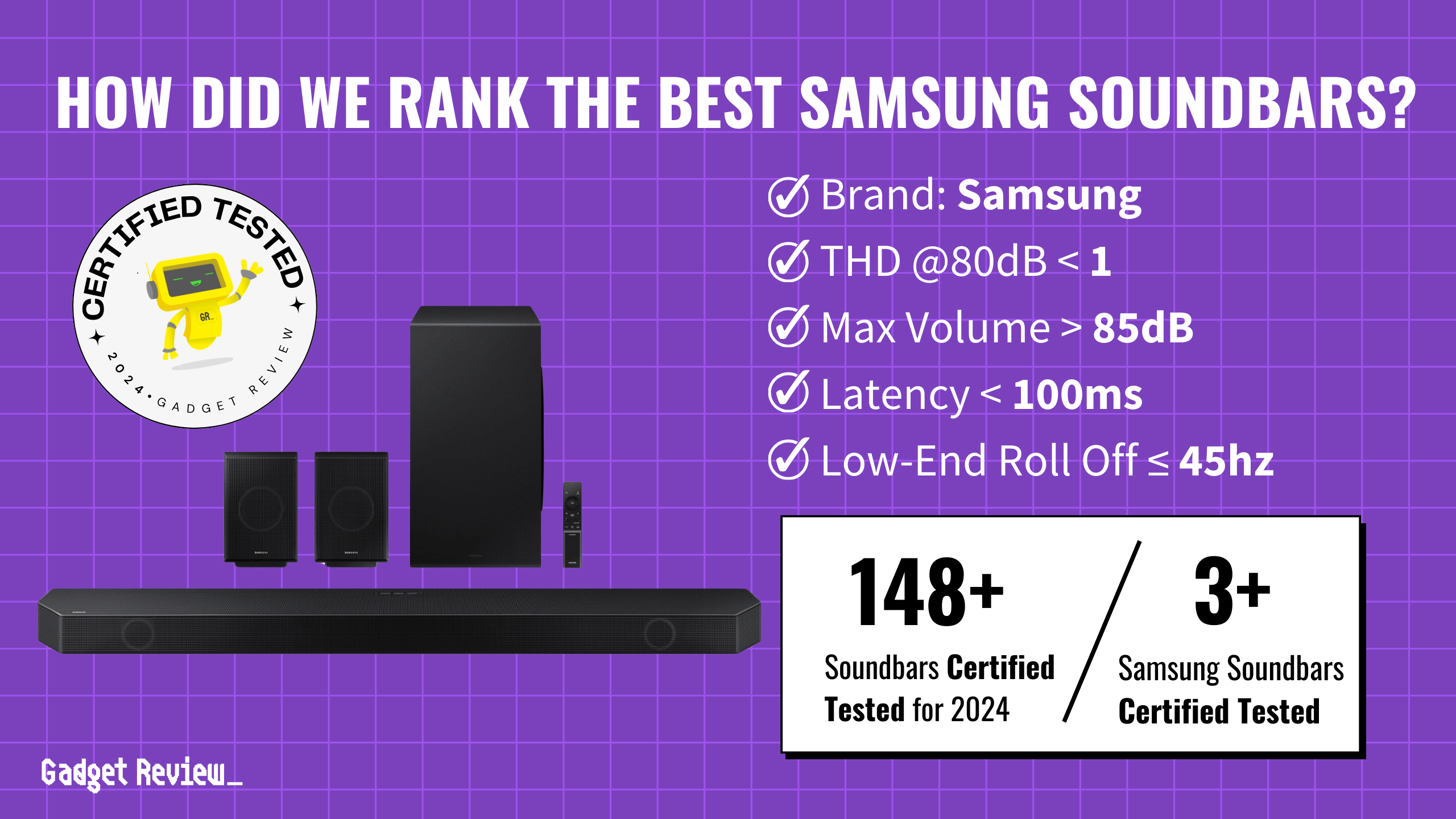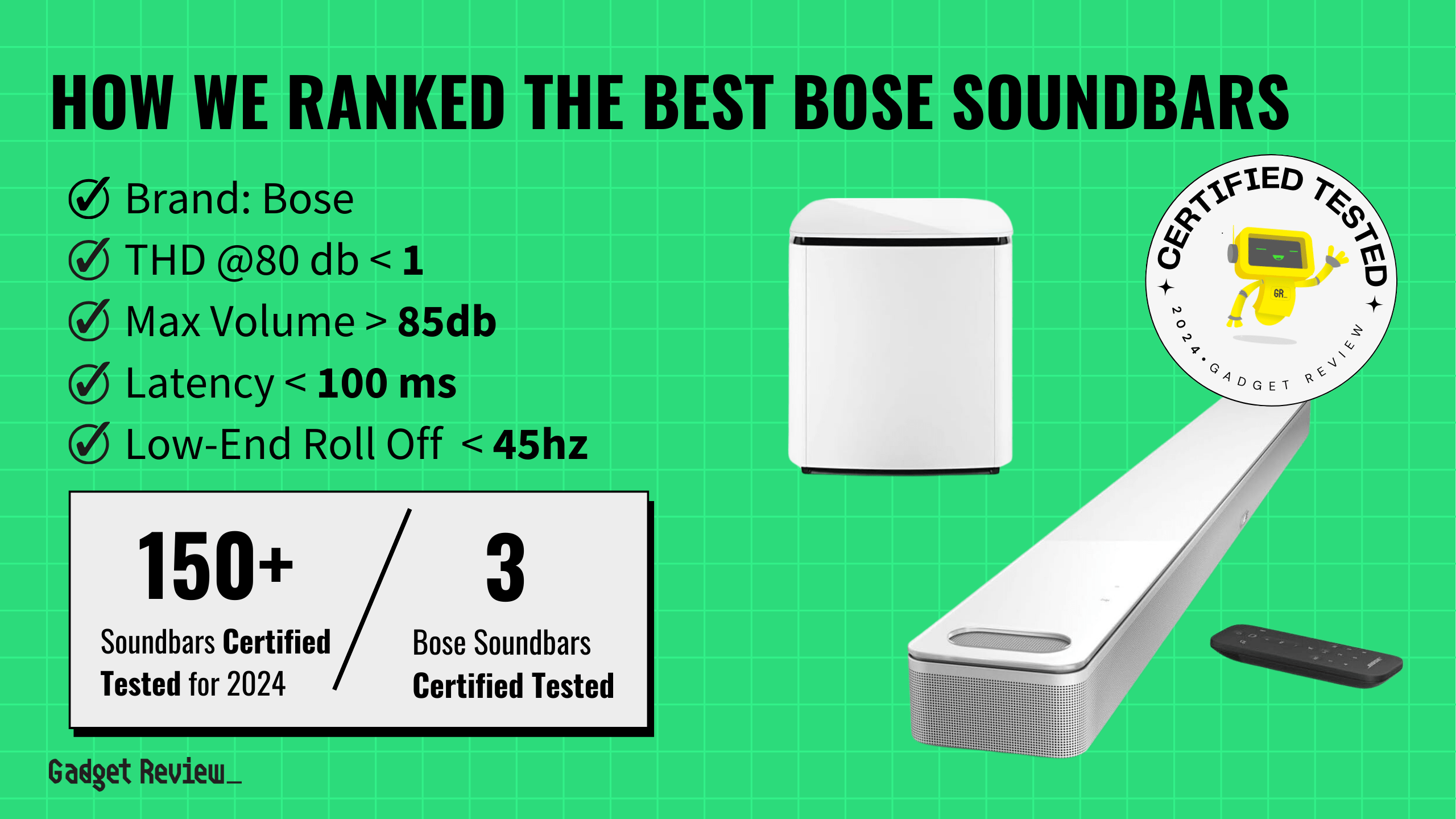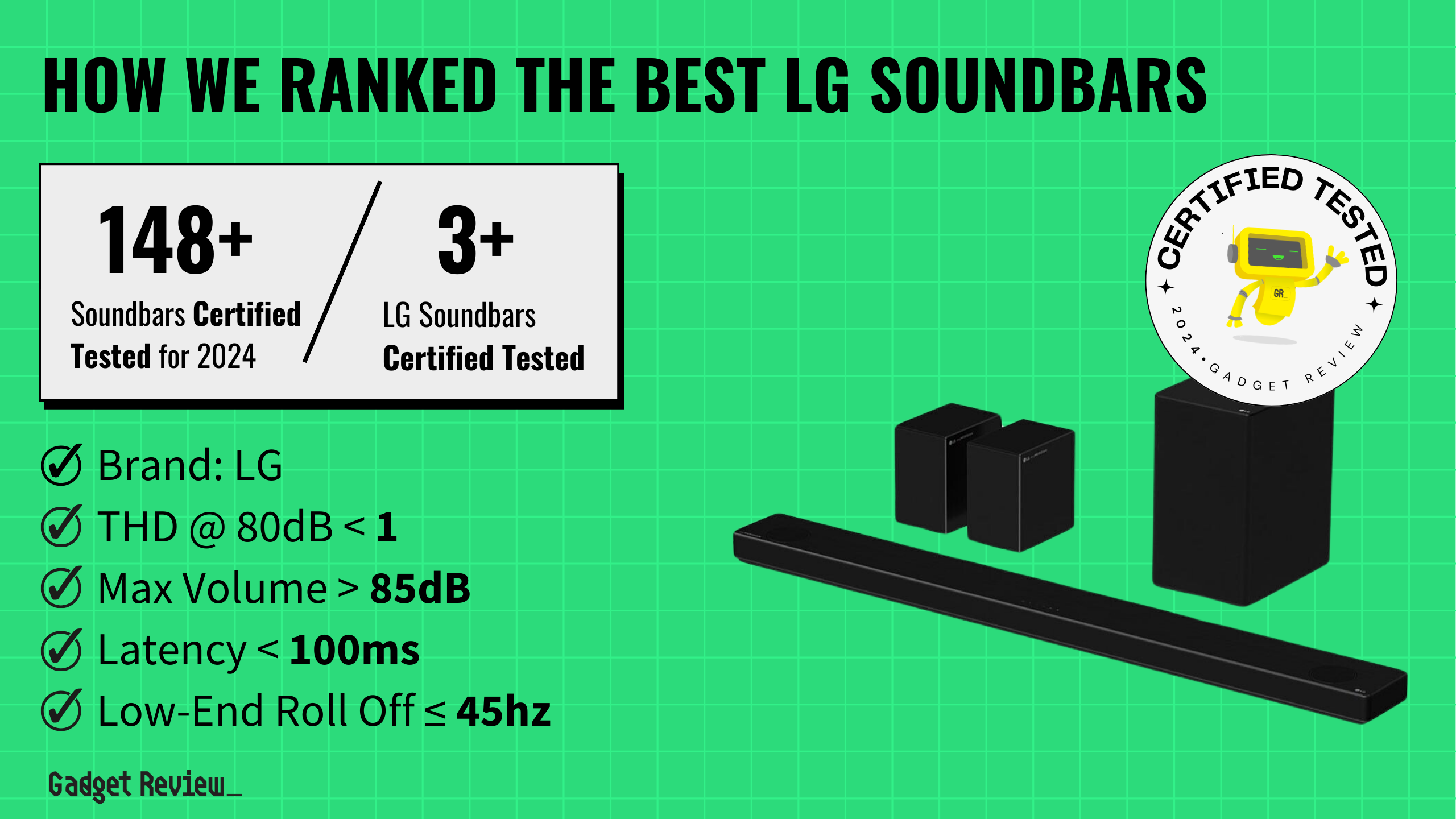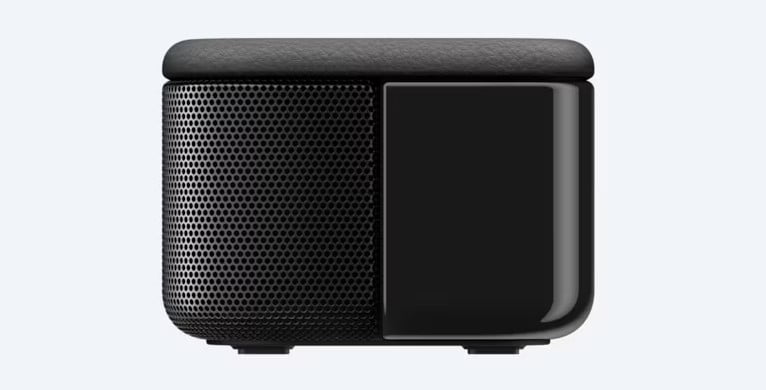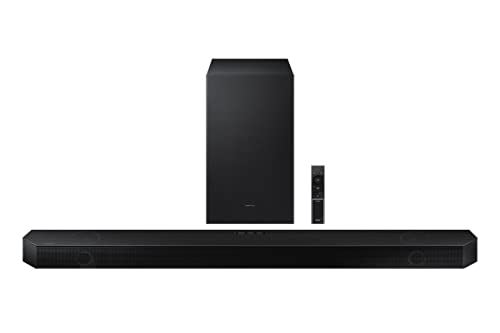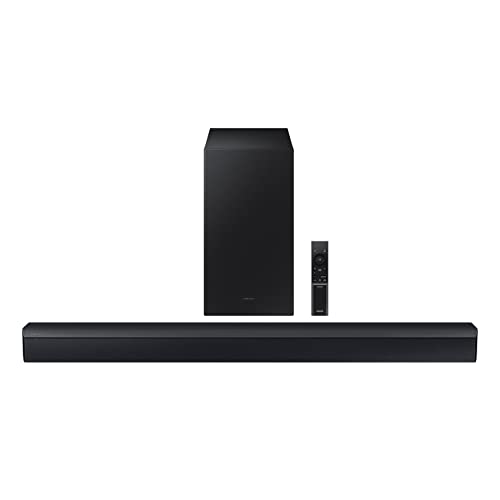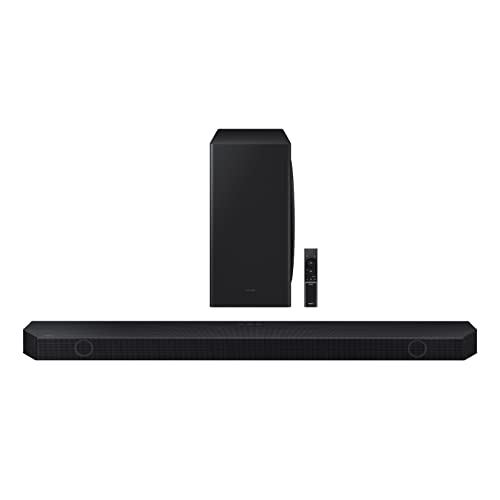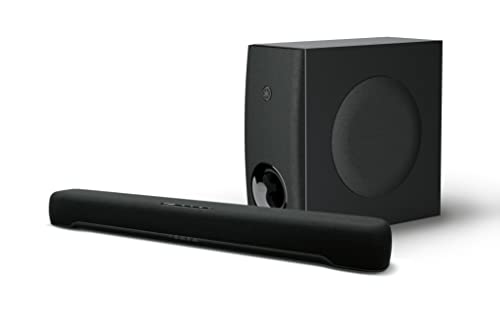If you want seamless integration with your home audio system, the best Sonos soundbars are designed to deliver premium audio quality, offering clear sound and deep bass right out of the box. Their compatibility with other Sonos devices allows you to build a multi-room audio experience easily controlled via the Sonos app. However, they might lack some of the advanced sound customization features found in other brands.
In our rigorous, data-driven analysis, three Sonos soundbars earned a spot in our buying guide. We examined over 140 soundbars, certifying products as tested, and analyzed 407,424 reviews. Shockingly, 92% of experts failed our Trust Rating, but our unique approach filtered out fake reviews. This meticulous process ensures that the best soundbar recommendations are based on reliable data. The winning Sonos models stood out for their superior performance and integration capabilities.
How Did We Rank the Best Sonos Soundbars?
To determine the best Sonos soundbar, we meticulously examined testing methodologies across over 200 websites. We explored customer reviews, assessed expert opinions, and analyzed our True Score to provide a comprehensive buying guide. Our analysis pinpointed the most critical criteria for soundbars: 2 essential test results, 2 desirable test outcomes, and 1 must-have specification. This rigorous process ensures you get the most accurate and reliable recommendations for your audio needs. When you shop through our links, you’re backing our mission. Dive deeper to see how.
?️ Minimum Specifications
- Must be Sonos
? Test Criteria
- Total Harmonic Distortion: A total harmonic distortion (THD) below 1% at 80 decibels to guarantee high-fidelity audio reproduction without unwanted frequencies.
- Volume Output: The volume output exceeds 85 decibels, delivering powerful and immersive sound performance.
? “Nice To Haves”
- Latency: With a latency under 100 milliseconds, it ensures minimal delay in data transmission or audio processing.
- Low-End Roll Off: A low-end roll-off of <45 Hz to ensure there is plenty of thump and rumble in the bass to enhance your music or movie-watching experience.
Latest Updates
- 04/09/2024: Published the list of best Sonos soundbars based on our True Score system.
Top Sonos Soundbars For 2025
Prices accurate at the time of publishing
To secure a spot on our list, a Sonos soundbar must meet our stringent criteria for audio performance and quality. If it doesn’t meet these standards, it won’t be featured!
Which Criteria Matters for Testing Best Sonos Soundbars?
By focusing on these criteria (2 required, 2 nice to have), anyone can quickly and easily compare these soundbars and how they’ll perform. This helps you make an informed decision and purchase a soundbar that will sound great.
| CRITERIA | RANGE | REQUIRED | DEFINITION |
|---|---|---|---|
| Total Harmonic Distortion | < 1 | Yes | The amount of distortion introduced by the soundbar when it processes an audio signal at a given volume (typically 80, 85 or maximum dB output.) |
| Max Volume | > 85 dB | Yes | The maximum volume that a soundbar reaches when it’s output it turned up to 100%. |
| Low End Roll Off | < 45 Hz | No (nice to have) | The point at which bass begins to sharply fall below the target response point on a frequency response graph, making harder to hear. |
| Latency | < 100 ms | No (nice to have) | The time it takes for a soundbar to process audio signal from a source and output it through the speakers. |
Our Trusted Data Sources
(Publication category Score is 80%+)
We looked at 120+ soundbar reviewers and while 10 are trustworthy (60%+ Trust Rating), we only use data from the testers that are “very trusted” which means a Trust Rating above 70%. The three we have listed below are our most trusted for soundbars.
Interested in a comprehensive analysis of our data sources? We’ve got you covered. Below, you’ll find a detailed list of every soundbar review website we’ve identified, organized by their respective Trust Ratings from highest to lowest. But we didn’t stop there. We’ve meticulously reviewed each publication and verified the data by checking whether the authors have bio links to MuckRack or LinkedIn. We’re committed to not only checking the facts but ensuring their veracity.
Soundbars Test Data & Results
1. total harmonic distortion test result
Total Harmonic Distortion (THD) measures the fidelity of soundbars by indicating the percentage of unwanted harmonics added to the original audio. A THD under 1 ensures minimal distortion, critical for preserving audio quality across music, movies and games. This low distortion level enhances clarity, maintains detail, and ensures a high-fidelity listening experience, crucial for understanding dialogues, appreciating music nuances, and immersing in game sounds.
We believe Sonos soundbars should have less than 1% THD because this helps confirm their ability to accurately reproduce a wide range of audio without perceptible distortion. We say “perceptible” because it’s impossible to remove all distortion, but you can reduce it to the point it’s impossible to notice. Low THD also helps improve your comfort by preventing fatigue during extended use, making it an essential for anyone that marathons movies, games or music.
harmonic distortion
< 1
Acceptable range of performance
Definition: The amount of distortion that exists in an audio signal when it is played back at a target volume.
Units of Measurement: None or %
Tools to Measure: Audio Analyzer
Why It’s Important:
High levels of distortion ruin audio quality. Keeping distortion low helps keep music accurate and high-fidelity.
Total Harmonic Distortion (lower is better)
2. max volume test result
max volume
>85 dB
Acceptable range of performance
Definition: The maximum volume that a soundbar is able to hit when the output is turned all the way up.
Units of Measurement: dB (Decibels)
Tools to Measure: Sound level or decibel meter
Why It’s Important:
Max volume is how you ensure you’ve got enough volume to fill large rooms and helps ensure clarity at normal listening levels.
Maximum volume is the easiest aspect of a soundbar to understand: it’s just how loud the soundbar itself will actually get. What’s less clear is why a Sonos soundbar getting loud is so important. While higher max volumes give you the ability the fill rooms with sound or use a soundbar as makeshift party speakers, they’re also responsible for helping ensure that audio stays clear when listening at normal listening levels.
This is commonly referred to as “headroom”, and having enough headroom on a soundbar means that the soundbar is able to play back sounds at a high enough level (and with good enough clarity) that the volume level you’ll normally listen to music, movies or games with will sound perfectly clear and distortion free. We recommend your Sonos soundbar have no less than 85 dB of maximum volume, but getting past 91 dB is ideal, and the higher you go, the better your soundbar is at filling larger and larger rooms.
Max Volume (in dB; higher is better)
3. Low end roll off test result
When it comes to getting the most bass you can out of your soundbar, low-end roll off is a great indicator of just how deep the bass on it can get. If a Sonos soundbar doesn’t have a roll off that starts deep enough into the bass part of the audio spectrum, then it’ll result in quiet or even absent bass, which removes most of the punch and impact of not only music, but also movies and video games. the longer it takes bass to roll off, the better.
When it comes to most soundbars for most use cases, we recommend a roll off that doesn’t start until at least 45 Hz, but it only gets better the further you go down. It’s worth noting that the roll off will only get so low, so don’t expect to find soundbars hitting the teens for roll off, but it isn’t uncommon for very bass-forward options to hit 30 Hz before roll off starts. By aiming for at least 45 Hz, you have a much better chance of getting the deep, rumbling bass you’re looking for out of your music, movies or games.
Low end roll off
< 45 Hz
Acceptable range of performance
Definition: The point at which bass begins to sharply decline and becomes rapidly inaudible.
Units of Measurement: Hz (Hertz)
Tools to Measure: Oscilloscope
Why It’s Important:
If bass takes longer to start rolling off, it’ll generally be more present in the audible parts of the audio spectrum put out by a soundbar, giving sound “punch” and “depth.”
Low end roll off (in Hz; lower is better)
4. latency test result
Large amounts of latency create problems when trying to sync up audio and video. While you’ve got a bit of wiggle room with how much of a delay can exist between the audio that comes out of your soundbar and the images on your TV, it’s not a ton. If there’s too much latency the mismatch starts to become obvious, and people start looking like they stopped talking while dialogue is still playing. This is especially concerning for gamers, who rely on audio and video to sync up well enough that the footprints you hear around the corner are accurately getting closer.
It’s for these reasons we recommend a latency less than 100 ms. For most content, this is a low enough delay that any mismatch is going to be largely unnoticed. If you’re a highly competitive gamer and don’t want to do calibration out of the box to line up the A/V, the lowest latency you can find is going to work best. For music and moves, though, 100 ms or less will work great.
latency
< 100 ms
Acceptable range of performance
Definition: Time it takes for the soundbar to process and produce the sound it receives from the source
Units of Measurement: milliseconds (ms)
Tools to Measure: Software
Why It’s Important:
Long delays create mismatches between audio and video, which breaks immersion and frustrates gamers.
Latency (in milliseconds; lower is better)
Best Sonos Soundbars: Mistakes To Avoid
- Not Considering Room Size and Layout: One common mistake is not taking into account the size and layout of the room where the soundbar will be used. Different Sonos soundbars have varying capabilities in terms of sound projection and room-filling abilities. Choosing a soundbar that is too small for a large room or too large for a small room can result in suboptimal audio performance. Proper soundbar placement is crucial to maximizing its performance; it should be centered beneath your TV, at ear level, to ensure the sound is directed optimally toward the listening area. For smaller spaces, the best small soundbar can deliver superior audio quality without overwhelming the room, ensuring that even compact environments enjoy a rich and balanced sound.
- Ignoring Compatibility: Another common mistake is ignoring compatibility with existing audio equipment or the devices you plan to use with the soundbar. Ensure that the Sonos soundbar you choose is compatible with your TV, streaming devices, or other audio sources. Additionally, if you plan to expand your Sonos system in the future, consider compatibility with other Sonos speakers and components. When choosing between HDMI vs Bluetooth for your soundbar, note that HDMI offers stability and supports advanced audio like Dolby Atmos, ideal for home theaters. Bluetooth, however, allows for convenient wireless streaming from various devices.
- Not Researching Features: Many consumers make the mistake of not thoroughly researching the features and capabilities of different Sonos soundbars before making a purchase. Each model may offer different features such as voice control, virtual surround sound, HDMI ARC support, and compatibility with various streaming services. By researching and comparing these features, you can choose the soundbar that best suits your needs and preferences. When considering soundbar vs surround sound, it’s essential to evaluate your space and audio expectations.
- Overlooking Setup and Installation Requirements: Some consumers overlook the setup and installation requirements of Sonos soundbars. Depending on the model, setup may involve connecting the soundbar to your TV, configuring audio settings, and integrating it into your home network. Additionally, consider whether you’ll need additional accessories such as mounting brackets or speaker stands. Failure to account for setup and installation requirements can lead to frustration and difficulties in getting the soundbar up and running properly. Furthermore, configuring how to control the soundbar with the TV remote can streamline your audio experience, allowing for seamless volume adjustments and power control directly from your TV’s remote, provided your soundbar supports HDMI-CEC or has a compatible learning feature.
The Best Sonos Soundbars Tests Compared
Product |
True Score
|
Low End Roll Off
|
High End Roll Off
|
Max Volume Test
|
Latency
|
THD @ 80dB
| |
|---|---|---|---|---|---|---|---|
89 |
|
|
|
|
| $599.00 $899 $300 | |
| 87 |
|
|
|
|
| $475.00 $499 $24 |
86 |
|
|
|
|
| $884.52 $899 $14 |

